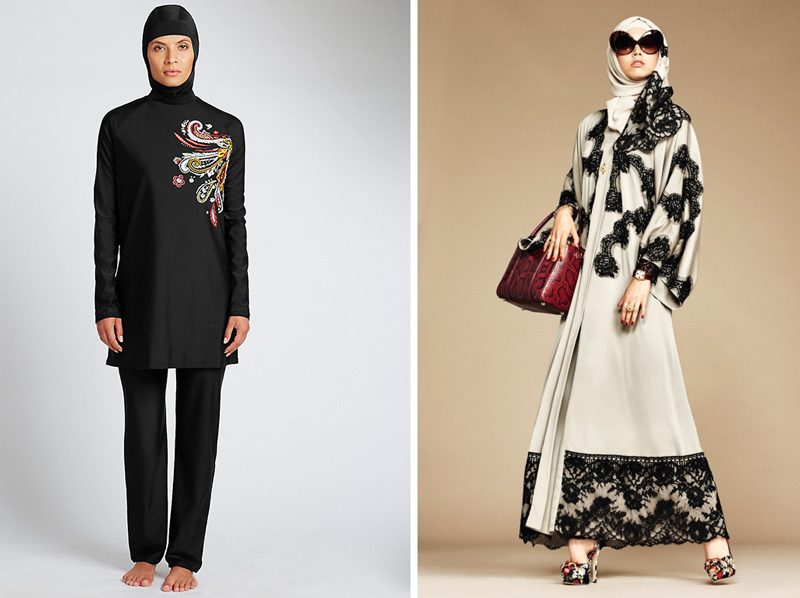As 2016 drew to a close, many people were on the edge of their seats after a defining presidential election between one choice (Clinton) who stood for the status quo and the other (Trump), seen as the harbinger of a resolute victory against radical Islam. For many Muslims, there was a third choice. Unanchored to the changing tides of elections, the long game of Western Muslims who are averse to Western values was largely unaffected by an altered political landscape. They had transitioned to a new arena: culture.
In 2016, the élite fashion label Dolce and Gabbana launched an “Abaya and Hijab Collection.” Months later, at New York Fashion Week, a sartorial Mecca, hosted the first catwalk spotlighting models fully donned in hijabs.
Islamist influence is now using Western culture to solidify Islamist values in society’s more coveted circles: fashion and beauty.

Left: Marks & Spencer’s Paisley Print Burkini. Right: An outfit from the Dolce & Gabbana Abaya and Hijab Collection. |
Melanie Elturk, CEO of Haute Hijab, a leading U.S. hijab brand, openly shared a widely held belief that “fashion is one of the outlets in which we can start that cultural shift in today’s society to normalize the hijab in America.”
Later in the year, CoverGirl, a popular affordable makeup line, announced Muslim beauty blogger Nura Afia as its newest “brand ambassador.” A 23-year-old wife and mother, Afia hosts a YouTube channel, with over 200,000 subscribers, for hijab and makeup tutorials. She now stands with celebrities such as CoverGirl’s first male makeup model, James Charles; Modern Family star Sofia Vergara and pop singer Katy Perry in a campaign that highlights brands of makeup targeted at customers who applaud surface “diversity” and “equality.”
Posing together for a CoverGirl campaign aimed at portraying “diversity” were a male makeup model, a “hijabi,” a Latina TV star and a pop singer. It is a visual tableau trying to appeal to an audience that prizes “diversity” — one that sees “equality” based entirely on appearance rather than values or intrinsic worth. Rather than inquire into the marketplace of ideas that explores identity, faith and American values, we now have advertising campaigns that homogenize competing ideas into the funnel of multiculturalism. In this instance, a noted pop singer and a TV star are used as gateways to usher in the hijab as normal and perhaps even coveted.
Beauty and fashion industries in particular offer a mold in which intellectual discourse and cultural commentary is cast aside for opinion. That opinion is then shaped, packaged, and pushed as a product onto a population group already pliable to messaging. With CoverGirl’s newest “brand ambassador,” Nura Afia, the message echoes the mantra of hardline Islamist groups who have, since the presidential election, lost much of their political ground. Lost ground is now regained in new spheres through personalities such as Afia, without any association with political parties.
Beautiful Nura Afia in an advertising campaign is a far more appealing and consumer-friendly alternative to CAIR’s Nihad Awad or the political complexities of the Muslim Brotherhood. The face has changed but the message has not.
In an earlier Refinery29 interview, Afia had this message to share:
“Islam is such a beautiful religion. It’s peaceful and everyone else twists it, even within our own faith. Just from looking at social media, [I see] Muslims bash Muslims, so if that’s happening I can’t believe that we expect non-Muslims not to do the same. It’s just how humans are, I guess. It has nothing to do with religion.”
Yet, in a Facebook post just a month prior, Afia also shared this:
“If you find yourself no longer my friend on FB it’s because you either shared or posted some straight up ignorant, racist, or bigoted [expletive].”
Here you have the two faces of Islamist thought. The PR-friendly face of Islamist thought underscores the myth of peace, while on the other hand Islamism exiles dissenting voices as ignorant, racist or bigoted.
Meanwhile, CoverGirl and other brands uphold the hijab as a new standard of beauty, ignore the hijab’s extremely ugly origins. A handful of Islamic scholars believe the practice of hijab grew out of exclusionary practices designed to draw a distinction between “believing” women (Muslims) and “non-believing” women (non-Muslims). Islamic culture embraces piety through veiling the body of Muslim women, while at the same time it strips non-Muslim women of their dignity by seeing them as property and spoils of war to be parceled and consumed — a practice allowed by the faith.
The origin of the hijab tradition in Islam likely pre-dates the Quran, and comes from early Islamic society. The Quran, a book that outlines civilian and military life to the most granular detail, does not offer any doctrine that specifically dictates covering the hair. The Quranic verse (33:59) believed to mandate the hijab states:
“O Prophet, tell your wives and your daughters and the women of the believers to bring down over themselves [part] of their outer garments. That is more suitable that they will be known and not be abused. And ever is Allah Forgiving and Merciful.”
The practice of covering the hair grew from a slave-owning society. Speaking on Surah 33:59-60, which advises believing women to cover their bodies, Professor Barlas circulates a widely-shared view among academics:
“These are rather straightforward verses: if Muslim women don an outer garment (jil-bab), non-Muslim men will recognize them as such and not harass them. In early slave-owning societies, like Arabia, the ‘law of the veil’ set apart free women from slaves and therefore women who were off-limits from those who ‘were fair game’ (Lerner in Ahmed 1992:15). This was the society in which the first Muslim community took shape and it seems to have been under siege at the time.”
Professor Barlas’s assessment is debated by some Islamic scholars based on what they say is insufficient evidence; other Islamic scholars, including Professor Khaleel Mohammed, argue that the claim has merit.
The larger point is this: slavery at the time was a standard practice. It thrived culturally through acts of social and religious demarcations, such as the hijab, which became to many Muslims a sign of class supremacy, whereas women who were not veiled have been, and continue to be, harassed and attacked[1]:
“Except from their wives or those their right hands possess, for indeed, they are not to be blamed…” (Surah 70, Verse 30, Al-Ma’aarej, Sahih International)
Islam, to its credit, introduced many incentives to shift away from a slave-owning society, by making it simple to free slaves. According to Hadith (Sahih Bukhari Vol 3, Book 46, Number 693), for example, Muslims are rewarded in the afterlife for the act of freeing a slave; freeing the body of a slave is like freeing one’s own body from hellfire. Still, while Islam did not initiate slavery and while it did create pathways to move out of the practice, the faith never championed the right of all people to be free.
This failure is largely responsible for present-day slavery in Mauritania, a country to which devout Muslims flock to study Islam in an environment free from Western influence. This failure has also continued to permit rapes. These take place not only during wars from Sudan to Syria and the horrifying present day open enslavement of Yazidi women and children by ISIS and at international slave auctions in neighboring countries such as Saudi Arabia, bit also it seems, by various migrants to Europe.
It is then a fantastic stretch of the imagination when brands such as CoverGirl try to have consumers associate “equality” and “diversity” with hijabs and make-up. It also does not mirror the “Islam of peace” that many Muslims try to emphasize.
These deeper conversations are lost when the market through which Afia reaches out is largely uninterested in history, facts or any other evidence that prompts inquiry or reflection.
For Islamists, Afia and CoverGirl make excellent proxies in the push for normalizing the rigidity in the system of Islam by making it “chic to celebrate oppression.” Contrary to modern-day fantasies of the hijab “breaking barriers,” the hijab historically was used as a social barrier.
Normalizing the hijab reinforces the message that if you are not covered, you are not respectable and therefore not acceptable. That is the underbelly of Islamic culture: it controls thought and movement before attempting to corral other women into submission under the spoon-fed illusion of “diversity” and “equality.”
Shireen Qudosi, Director of Muslim Matters, at America Matters, is an American Muslim raised on three continents. She is writing her first book, Islam’s Origin Story.
[1] The Islamic scholar Dr. Tawfik Hamid also wrote a compelling piece, “Hijab, Even American Flag Hijab, Supports Historical Slave System.” Relying on multiple Islamic sources as evidence, Dr. Hamid exposes how the “hijab is a dress code in Islam that was designed to distinguish ‘free’ from ‘slave’ women.” Other modern Islamic thinkers, such as Asra Nomani and Hala Arafa add that Surah 33:59 wasn’t instruction to add a new layer of fabric, but to draw closer the jilbab (a long, overflowing gown) that was common at the time. Nomani and Arafa also cite the eight times “hijab” or its variation has appeared in the Quran; each time it was not in reference to piety but to draw distinction and barriers between two things:
The word hijab, or a derivative, appears only eight times in the Quran as an “obstacle” or “wall of separation” (7:46), a “curtain” (33:53), “hidden” (38:32), just a “wall of separation” (41:5, 42:52, 17:45), “hiding” (19:14) and “prevented” or “denied access to God” (83:15).”
Multiple references, both primary and secondary sources, point back to the hijab’s origin as not an act of piety, but an act of supremacy and distinction that made it easier for a slave system to thrive.
























